We’d like to remind Forumites to please avoid political debate on the Forum.
This is to keep it a safe and useful space for MoneySaving discussions. Threads that are – or become – political in nature may be removed in line with the Forum’s rules. Thank you for your understanding.
The MSE Forum Team would like to wish you all a Merry Christmas. However, we know this time of year can be difficult for some. If you're struggling during the festive period, here's a list of organisations that might be able to help
📨 Have you signed up to the Forum's new Email Digest yet? Get a selection of trending threads sent straight to your inbox daily, weekly or monthly!
Has MSE helped you to save or reclaim money this year? Share your 2025 MoneySaving success stories!
Best exercise for sore back?
Wizard_of_Id
Posts: 5,512 Forumite
I have developed a painful lower back and I'm looking to exercise it away, has anyone got any similar experience?
I'm not looking for medical advice, just examples of different gentle exercises so that I can choose one that might work for me.
I'm not looking for medical advice, just examples of different gentle exercises so that I can choose one that might work for me.
0
Comments
-
Walking is the best exercise, even though it doesn't seem so at the time.
Also, a tens machine is well worth the money.0 -
I have a Yantra Mat, google it, it really works.
It works on the pressure points and gives so much relief.
and a warm hot water bottlemake the most of it, we are only here for the weekend.
and we will never, ever return.0 -
I would suggest you see someone to find out why it is hurting first - as what you think may be helping could be making it worse.
There's a lot you can do, but you need to know the cause first - take it from someone who has had three surgeries on her spine because she went to the gym because her back hurt (and another two surgeries to go!). I'm the exception rather than the rule, but always always get it checked, even if it is a private physio rather than your GP.0 -
After ruling all the basics out (slipped disk, fractured bones, trapped nerve...etc) and are sure it is muscular, there are a few things which are supposed to be good for back pain BUT! Make very sure your instructor is aware of your problem and is trained in knowing how to help. I've witnessed some really bad instructors in my time and if you end up with one of these at best they wont do anything, at worse they could make things worse.
Pilates. Things which train your core (Pilates is most focused on this). Your core isn't just the front of your chest; it's a huge wrap-around area which goes up as high as your sternum and as low as your thighs and covers most of your back. Learning how to move better and also how to disperse the pressure your back will no doubt be unevenly taking on and overcompensating for will in time help your back pain but don't expect a quick fix.
Swimming is great as it takes the pressure from the lower part of your back and depending on the stroke used will also mean you are in a posture where you are not as hunched inward (we all do this!) and will mean upper back muscles are used and worked on and in time will help share the tension and weight of the rest of your body.
If you want to work on building up your back, many things can help but make sure you are not in too much pain first. Pain often means you hold your posture differently and often are more ridged. This means you are more prone to muscle pulls, tears and further injury. If you are OK enough to not have this affect your posture though; boxing, forms of yoga where you move through more advanced series and balance on your arms more, weights where you move in unusual ways (not just the basic front/side/back plane) eg things like Kettle Balls and so on.
And lastly, remember to rest, remember to not push past the pain; just up to it. And if you take medication to reduce inflammation this can be taken before, paracetamol is better left to after as you need to feel a certain amount of the pain to know when it's wise to stop and it's OK to keep going.
Oh and water. Sounds like the most irrelevant thing to suggest I know. But (without typing another essay here) you will just have to take my word for it, water and rest are very important to aid recovery.0 -
We should consider the exercises especially in case of sore back!
Lower Back Pain: How Exercise Helps
You may feel like resting, but moving is good for your back. Exercises for lower back pain can strengthen back, stomach, and leg muscles. They help support your spine, relieving back pain. Always ask your health care professional before doing any exercise for back pain. Depending on the cause and intensity of your pain, some exercises may not be recommended and can be harmful.
Avoid: Toe Touches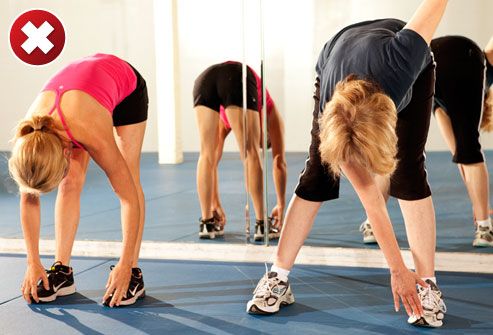
Exercise is good for low back pain -- but not all exercises are beneficial. Any mild discomfort felt at the start of these exercises should disappear as muscles become stronger. But if pain is more than mild and lasts more than 15 minutes during exercise, patients should stop exercising and contact a doctor. Some exercises may aggravate pain. Standing toe touches, for example, put greater stress on the disks and ligaments in your spine. They can also overstretch lower back muscles and hamstrings.
Try: Partial Crunches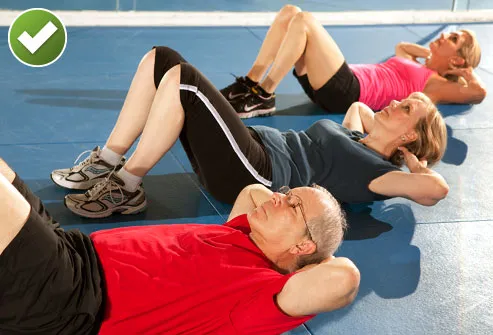
Some exercises can aggravate back pain and should be avoided when you have acute low back pain. Partial crunches can help strengthen your back and stomach muscles. Lie with knees bent and feet flat on the floor. Cross arms over your chest or put hands behind your neck. Tighten stomach muscles and raise your shoulders off the floor. Breathe out as you raise your shoulders. Don't lead with your elbows or use arms to pull your neck off the floor. Hold for a second, then slowly lower back down. Repeat 8 to 12 times. Proper form prevents excessive stress on your low back. Your feet, tailbone, and lower back should remain in contact with the mat at all times.
Avoid: Sit-ups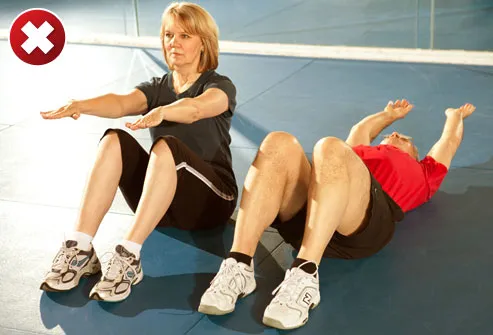
Although you might think sit-ups can strengthen your core or abdominal muscles, most people tend to use muscles in the hips when doing sit-ups. Sit-ups may also put a lot of pressure on the discs in your spine.
Try: Hamstring Stretches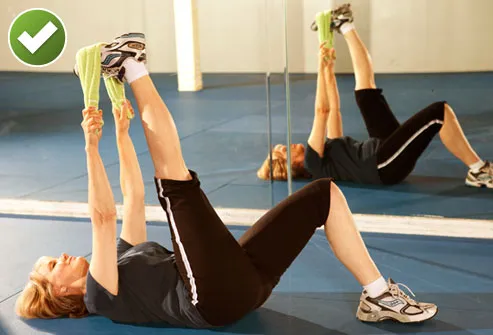
Lie on your back and bend one knee. Loop a towel under the ball of your foot. Straighten your knee and slowly pull back on the towel. You should feel a gentle stretch down the back of your leg. Hold for at least 15 to 30 seconds. Do 2 to 4 times for each leg.
Avoid: Leg Lifts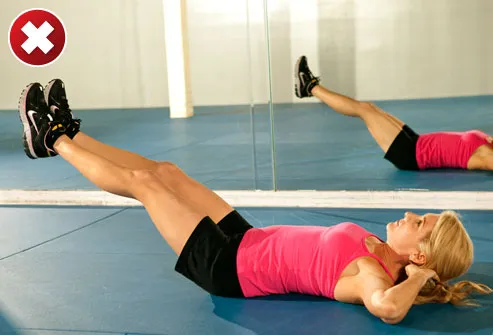
Leg lifts are sometimes suggested as an exercise to "strengthen your core" or abdominal muscles. Exercising to restore strength to your lower back can be very helpful in relieving pain yet lifting both legs together while lying on your back is very demanding on your core. If weak, this exercise can make back pain worse. Instead, try lying on your back with one leg straight and the other leg bent at the knee. Keeping your lower back flat on floor. Slowly lift the straight leg up about 6 inches and hold briefly. Lower leg slowly. Repeat 10 times, then switch legs.
Try: Wall Sits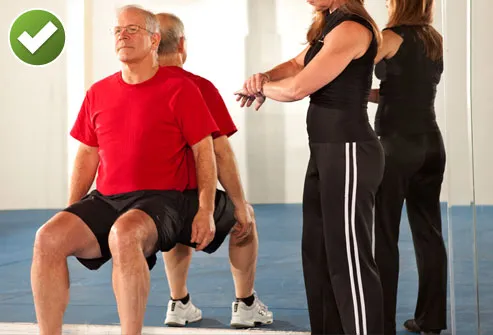
Stand 10 to 12 inches from the wall, then lean back until your back is flat against the wall. Slowly slide down until your knees are slightly bent, pressing your lower back into the wall. Hold for a count of 10, then carefully slide back up the wall. Repeat 8 to 12 times.
Try: Press-up Back Extensions
Lie on your stomach with your hands under your shoulders. Push with your hands so your shoulders begin to lift off the floor. If it's comfortable for you, put your elbows on the floor directly under your shoulders and hold this position for several seconds.
Try: Bird Dog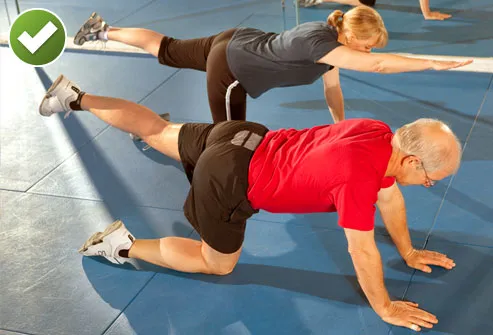
Start on your hands and knees, and tighten your stomach muscles. Lift and extend one leg behind you. Keep hips level. Hold for 5 seconds, and then switch to the other leg. Repeat 8 to 12 times for each leg, and try to lengthen the time you hold each lift. Try lifting and extending your opposite arm for each repetition. This exercise is a great way to learn how to stabilize the low back during movement of the arms and legs. While doing this exercise don't let the lower back muscles sag. Only raise the limbs to heights where the low back position can be maintained.
Try: Knee to Chest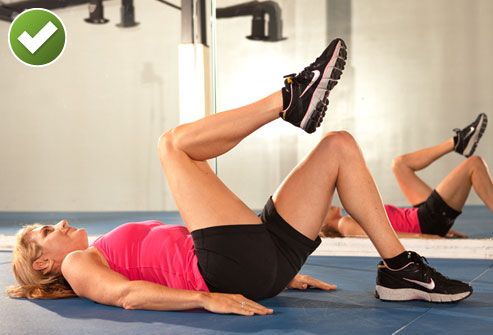
Lie on your back with knees bent and feet flat on the floor. Bring one knee to your chest, keeping the other foot flat on the floor. Keep your lower back pressed to the floor, and hold for 15 to 30 seconds. Then lower your knee and repeat with the other leg. Do this 2 to 4 times for each leg.
Try: Pelvic Tilts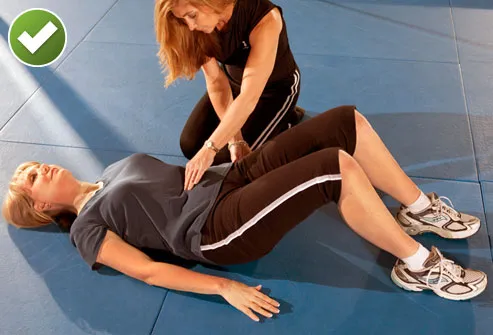
Lie on your back with knees bent, feet flat on floor. Tighten your stomach by contracting it as though you were preparing for a punch. You’ll feel your back pressing into the floor, and your hips and pelvis rocking back. Hold for 10 seconds while breathing in and out smoothly. Repeat 8 to 12 times.
Try: Bridging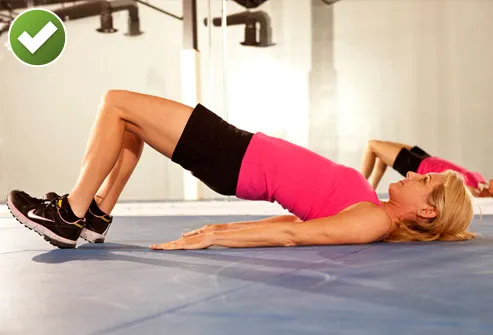
Lie on your back with knees bent and just your heels on the floor. Push your heels into the floor, squeeze your buttocks, and lift your hips off the floor until shoulders, hips, and knees are in a straight line. Hold about 6 seconds, and then slowly lower hips to the floor and rest for 10 seconds. Repeat 8 to 12 times. Avoid arching your lower back as your hips move upward. Avoid overarching by tightening your abdominal muscles prior and throughout the lift.
Lifting Weights May Help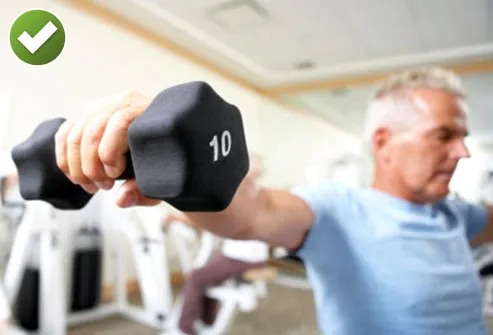
Done properly, lifting weights doesn't usually hurt your back. In fact, it may help relieve chronic back pain. But when you have acute (sudden) back pain, putting extra stress on back muscles and ligaments could raise risk of further injury. Ask your doctor whether you should lift weights, and which exercises to avoid.
Try: Aerobic Exercise
Aerobic exercise strengthens your lungs, heart, and blood vessels and can help you lose weight. Walking, swimming, and biking may all help reduce back pain. Start with short sessions and build up over time. If your back is hurting, try swimming, where the water supports your body. Avoid any strokes that twist your body.
Try: Some Pilates Moves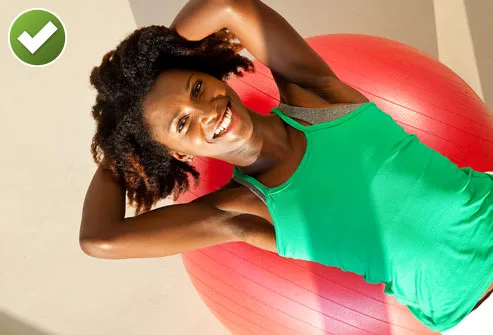
Pilates combines stretching, strengthening, and core abdominal exercises. Under the instruction of an experienced teacher, it may help some people with back pain. Be sure to tell your teacher about your back pain, because you may need to skip some moves.
:beer::j0 -
I think you really, really should be looking for medical advice - see your GP before you do anything to make that painful lower back even more painful.Wizard_of_Id wrote: »I have developed a painful lower back and I'm looking to exercise it away, has anyone got any similar experience?
I'm not looking for medical advice, just examples of different gentle exercises so that I can choose one that might work for me.0 -
Wizard_of_Id wrote: »I have developed a painful lower back and I'm looking to exercise it away, has anyone got any similar experience?
I'm not looking for medical advice, just examples of different gentle exercises so that I can choose one that might work for me.
I recommend Pilates. That has 99% solved my back problems. For example, my back used to be very sore if I bent down to weed the garden for just a couple of minutes. Having done Pilates regularly for a couple of years I can now bend to weed for half an hour or more and stand up with no soreness whatsoever. Do start gently though - some places will have Pilates classes aimed at beginners. And do tell the instructor about your back problem as they may modify some of the exercises for you.0 -
Thanks for all the pointers and tips, I already do a lot of them.
I did ask the nurse last time I was in and she said that all the walking I am doing should help as long as I 'warmed down' before slumping into my chair when I got home. As I still have full movement, she has put it down to old age and slouching when sitting (I do tend to do that).0 -
I concur with the Pilates suggestion. A couple of doctors had suggested it over the years and I eventually started taking classes. It took me a few visits to get into it but once I got the idea it's been great.
The place I used was excellent with teachers who knew their stuff (particularly the owner). My pain was explained to me that I'd started using my back muscles rather than those at the front to support my back and now and again they just give up as it's too much for them.
My back is far from perfect and still give me trouble but I'm much more aware of how to handle it.0 -
Wizard_of_Id wrote: »Thanks for all the pointers and tips, I already do a lot of them.
I did ask the nurse last time I was in and she said that all the walking I am doing should help as long as I 'warmed down' before slumping into my chair when I got home. As I still have full movement, she has put it down to old age and slouching when sitting (I do tend to do that).
I hope you realise the irony in what you said there
(It's difficult I know but you have to think of things like posture correction as a new lifestyle change rather than something you can dip in and out of or you just ruin all your efforts when you go back to what you were doing before. Slumping, pre/post/during a workout however amazing the workout or class was can and will still exacerbate your back pain, - think of it like this; if a builder who has very strong muscles, lifts things badly, he can still injure himself by pulling a muscle to pick up a small child or even a pile of books if he doesn't pick it up properly (bend knees rather than stretching to pick things up). In this sense he/she is like anyone else; regardless of how strong his arms and back muscles are; the body works as a whole not in parts).
Also if you can, try to focus on posture and taking shorter walks where you focus throughout on your posture (so walks of 5-10 minutes max a few times a day rather than one long walk). The reason for suggesting this is because it is very easy to fall back into bad habits and most of the population will naturally have poor posture as a bad habit. It is also very difficult to focus on how we walk (or posture and walking correctly) for more than a few minutes at best because our minds wander, because it's boring and because we think we're doing what we are asking of ourselves when actually we've slipped back and don't realise.
If you can find a walking buddy who will be brutally honest with you this is great but I can imagine that would be tricky to sort out on a regular basis.
And another thing to remember is eating and sleeping well, (in addition to hydration) not an obvious part of the solution but an important one.0
This discussion has been closed.
Confirm your email address to Create Threads and Reply

Categories
- All Categories
- 352.9K Banking & Borrowing
- 253.9K Reduce Debt & Boost Income
- 454.7K Spending & Discounts
- 246K Work, Benefits & Business
- 602.1K Mortgages, Homes & Bills
- 177.8K Life & Family
- 259.9K Travel & Transport
- 1.5M Hobbies & Leisure
- 16K Discuss & Feedback
- 37.7K Read-Only Boards





